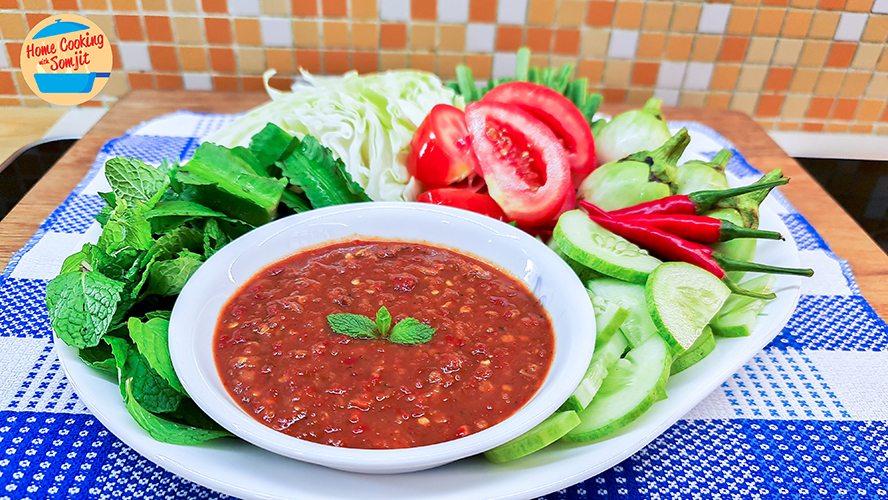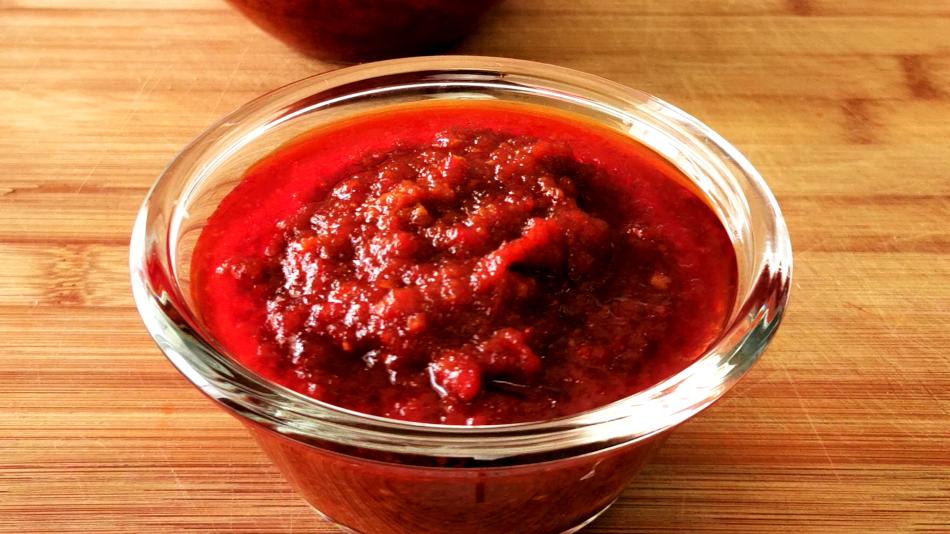Embark on a culinary journey into the vibrant world of vegetarian sambal belacan, a beloved condiment hailing from Southeast Asia. This tantalizing blend of spices, aromatics, and umami-rich ingredients has captivated taste buds for centuries, adding a burst of flavor to countless dishes.
Join us as we explore the origins, ingredients, and culinary significance of vegetarian sambal belacan, unveiling its versatility and the joy it brings to every meal.
Vegetarian sambal belacan is a testament to the creativity and adaptability of plant-based cuisine. It showcases the harmonious marriage of spicy chilies, savory fermented soybeans, and aromatic spices, creating a symphony of flavors that will leave you craving more. Whether you’re a seasoned cook or a novice in the kitchen, this guide will provide you with all the knowledge and inspiration you need to master the art of vegetarian sambal belacan.
Introduction to Vegetarian Sambal Belacan
Vegetarian sambal belacan is a spicy condiment originating from Malaysia and Indonesia. It is a popular accompaniment to rice dishes, grilled meats, and vegetables.Sambal belacan is traditionally made with a combination of chili peppers, shallots, garlic, shrimp paste, and lime juice.
However, the vegetarian version omits the shrimp paste, replacing it with other ingredients such as tofu or tempeh. This substitution maintains the spicy and flavorful profile of the original sambal belacan while catering to vegetarian preferences.
Ingredients and Variations
Vegetarian sambal belacan is a versatile dish that can be made with a variety of ingredients. The following list provides the basic components of a vegetarian sambal belacan recipe:
- Belacan: This is a fermented shrimp paste that gives sambal belacan its distinctive flavor. Vegetarian belacan can be made from fermented soybeans, chickpeas, or other plant-based ingredients.
- Chillies: Sambal belacan is typically made with a combination of fresh and dried chillies. The type of chillies used will determine the spiciness of the dish.
- Shallots: Shallots add a sweet and pungent flavor to sambal belacan.
- Garlic: Garlic adds a savory and aromatic flavor to the dish.
- Tomatoes: Tomatoes add a bit of sweetness and acidity to sambal belacan.
- Sugar: Sugar is used to balance the spiciness of the chillies.
- Salt: Salt is used to enhance the flavor of the dish.
- Oil: Oil is used to fry the ingredients and create a smooth paste.
There are many variations of vegetarian sambal belacan, each with its own unique flavor and texture. Some popular variations include:
- Sambal belacan hijau: This variation is made with green chillies, which gives it a brighter color and a slightly milder flavor.
- Sambal belacan terasi: This variation is made with terasi, a fermented shrimp paste that has a stronger flavor than belacan.
- Sambal belacan mangga: This variation is made with mango, which adds a sweet and fruity flavor to the dish.
Cooking Methods and Techniques
Preparing vegetarian sambal belacan involves a simple yet flavorful cooking process. Let’s delve into the step-by-step guide and explore some tips to enhance the taste and texture.
To begin, heat a wok or skillet over medium heat. Add a generous amount of vegetable oil and allow it to shimmer. Once the oil is hot, add the sliced shallots and garlic and sauté until fragrant and slightly golden.
Tempering the Spices
Next, add the ground dried chilies, turmeric, and cumin seeds. Stir constantly to prevent burning. This step is crucial for tempering the spices and releasing their aromatic flavors.
Adding the Base Vegetables
Once the spices are fragrant, add the diced tomatoes and green chilies. Sauté until the tomatoes soften and release their juices. This forms the base of the sambal belacan.
Incorporating the Belacan
Now, add the belacan paste and stir well to combine. Cook for a few minutes until the belacan melts and infuses its distinct umami flavor into the sambal.
Balancing the Flavors
To balance the flavors, add a touch of palm sugar or brown sugar. This will counteract the spiciness and add a subtle sweetness to the sambal. Additionally, a squeeze of lime juice can enhance the freshness and brightness.
Simmering and Thickening
Finally, add a splash of water or vegetable broth and simmer the sambal for 10-15 minutes, or until it reaches your desired consistency. The longer you simmer, the thicker the sambal will become.
Finishing Touches
Once the sambal has thickened, remove it from the heat and stir in chopped coriander leaves for an aromatic garnish. Serve hot with rice, vegetables, or your favorite dishes.
Flavor Profile and Sensory Characteristics
Vegetarian sambal belacan boasts a complex and distinctive flavor profile that tantalizes the taste buds. Its spiciness, acidity, and umami notes are carefully balanced, creating a harmonious symphony of flavors.
Spiciness
The chili peppers used in vegetarian sambal belacan provide a vibrant heat that ranges from mild to intense, depending on the variety chosen. The capsaicin in the chili peppers activates the TRPV1 receptors on the tongue, sending signals to the brain that trigger the sensation of heat.
Acidity
Tomatoes and tamarind contribute a refreshing acidity to the sambal belacan. The citric acid in tomatoes provides a bright, tangy flavor, while the tartaric acid in tamarind adds a more complex sourness. This acidity balances the spiciness of the chili peppers, creating a pleasant interplay of flavors.
Umami
Vegetarian sambal belacan is rich in umami, a savory flavor that is often associated with meat. This umami comes from the fermented soybeans used in the belacan paste, as well as from the addition of mushrooms or other umami-rich ingredients.
The umami notes provide depth and richness to the sambal belacan, making it a satisfying and flavorful condiment.
Nutritional Value and Health Benefits

Vegetarian sambal belacan is a nutrient-rich condiment that offers several health benefits. It is a good source of vitamins, minerals, and antioxidants.
Some of the key nutrients found in vegetarian sambal belacan include:
- Vitamin C: An antioxidant that helps protect cells from damage.
- Vitamin A: Essential for vision, immune function, and skin health.
- Potassium: An electrolyte that helps regulate blood pressure and fluid balance.
- Iron: Necessary for the production of red blood cells.
- Fiber: Promotes digestive health and helps lower cholesterol levels.
In addition to these nutrients, vegetarian sambal belacan also contains a number of beneficial compounds, such as:
- Capsaicin: The compound that gives chili peppers their heat, has been shown to have anti-inflammatory and pain-relieving properties.
- Curcumin: A compound found in turmeric, has been shown to have antioxidant and anti-inflammatory properties.
- Gingerol: A compound found in ginger, has been shown to have anti-nausea and anti-inflammatory properties.
These compounds, along with the vitamins and minerals found in vegetarian sambal belacan, contribute to its overall health benefits.
Potential Health Benefits
Vegetarian sambal belacan has been linked to a number of potential health benefits, including:
- Reduced inflammation: The capsaicin, curcumin, and gingerol in vegetarian sambal belacan have all been shown to have anti-inflammatory properties.
- Improved digestion: The fiber in vegetarian sambal belacan helps promote digestive health and can help relieve constipation.
- Lowered cholesterol levels: The fiber in vegetarian sambal belacan can help lower cholesterol levels by binding to cholesterol in the digestive tract and preventing it from being absorbed into the bloodstream.
- Boosted immunity: The vitamin C in vegetarian sambal belacan helps support the immune system and protect against infection.
- Reduced pain: The capsaicin in vegetarian sambal belacan has been shown to have pain-relieving properties.
While more research is needed to confirm the health benefits of vegetarian sambal belacan, the available evidence suggests that it is a healthy and nutritious condiment that can offer a number of health benefits.
Serving Suggestions and Accompaniments
Vegetarian sambal belacan is a versatile condiment that can be enjoyed in various ways. Its spicy, savory, and slightly tangy flavors make it an excellent accompaniment to many dishes.
As a condiment, vegetarian sambal belacan can be served alongside grilled or roasted meats, vegetables, or tofu. It adds a flavorful kick to burgers, sandwiches, wraps, and tacos. It can also be used as a dipping sauce for appetizers like spring rolls, dumplings, or crackers.
Accompaniments
- Rice: Vegetarian sambal belacan pairs well with steamed rice or fried rice. The spicy and savory flavors of the sambal complement the mild taste of rice, creating a harmonious balance.
- Noodles: Sambal belacan can be added to noodle dishes like stir-fries, soups, or salads. It adds a flavorful depth and complexity to the dish, making it more satisfying.
- Vegetables: Vegetarian sambal belacan can be used as a marinade for grilled or roasted vegetables. It infuses the vegetables with its spicy and savory flavors, creating a delicious and flavorful side dish.
Cultural Significance and Regional Variations

Vegetarian sambal belacan holds significant cultural value in Southeast Asia, particularly in Indonesia and Malaysia, where it is an integral part of traditional cuisine.
Across different regions, variations in recipes and flavors exist due to the influence of local ingredients, culinary traditions, and cultural preferences.
Indonesia
- In Java, vegetarian sambal belacan is often made with a combination of tomatoes, shallots, garlic, and chili peppers, creating a spicy and flavorful condiment.
- In Sumatra, a sweeter version is popular, incorporating pineapple and brown sugar into the mix.
- In Bali, sambal belacan is often served with grilled satay or as a dipping sauce for vegetable tempura.
Malaysia
- In the northern states, vegetarian sambal belacan typically uses a blend of fresh chili peppers, onions, and shrimp paste, resulting in a tangy and aromatic sauce.
- In the southern regions, it is often made with roasted peanuts and coconut, creating a richer and more complex flavor profile.
- In Sarawak, a unique variation includes the use of wild ginger flower, imparting a distinctive floral note to the sambal.
Outcome Summary
As we conclude our exploration of vegetarian sambal belacan, it’s evident that this condiment is more than just a culinary delight; it’s a cultural treasure that embodies the vibrant flavors and traditions of Southeast Asia. Whether you’re using it as a dipping sauce, a marinade, or a flavor enhancer, vegetarian sambal belacan has the power to transform any meal into a memorable culinary experience.
Embrace its versatility, experiment with different variations, and discover the endless possibilities that this flavorful condiment has to offer.
FAQ Summary
Is vegetarian sambal belacan truly vegetarian?
Yes, vegetarian sambal belacan is made without any animal products, including shrimp paste. Instead, it relies on fermented soybeans and other plant-based ingredients to achieve its umami-rich flavor.
How spicy is vegetarian sambal belacan?
The spiciness level of vegetarian sambal belacan can vary depending on the type of chilies used. Some recipes call for milder chilies, while others use hotter varieties. You can adjust the heat level to your preference by choosing the appropriate chilies.
Can I make vegetarian sambal belacan ahead of time?
Yes, vegetarian sambal belacan can be made ahead of time and stored in an airtight container in the refrigerator for up to a week. This makes it a convenient condiment to have on hand for quick and flavorful meals.
